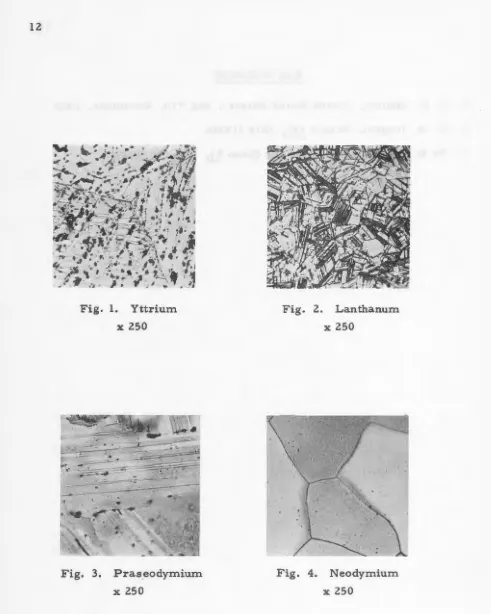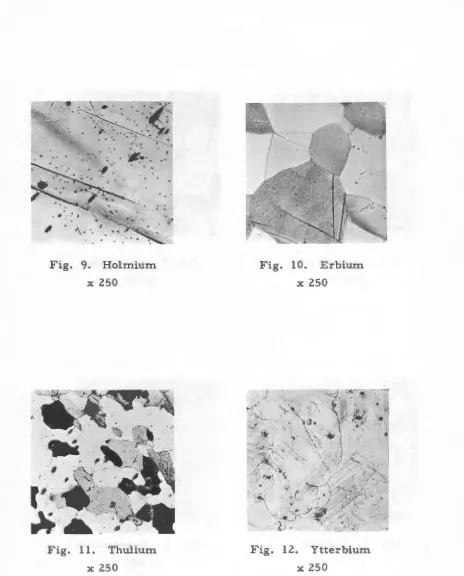Ames Laboratory Technical Reports
Ames Laboratory
10-1964
Electropolishing the rare-earth metals
D. T. Peterson
Iowa State University
E. N. Hopkins
Iowa State UniversityFollow this and additional works at:
http://lib.dr.iastate.edu/ameslab_isreports
Part of the
Ceramic Materials Commons, and the
Metallurgy Commons
This Report is brought to you for free and open access by the Ames Laboratory at Iowa State University Digital Repository. It has been accepted for inclusion in Ames Laboratory Technical Reports by an authorized administrator of Iowa State University Digital Repository. For more information, please contactdigirep@iastate.edu.
Recommended Citation
Peterson, D. T. and Hopkins, E. N., "Electropolishing the rare-earth metals" (1964).Ames Laboratory Technical Reports. 84.
Electropolishing the rare-earth metals
Abstract
This paper describes a method whereby the rare-earth metals can be consistently electropolished and chemically etched. The method involves cooling an alcohol-perchloric electrolyte to -76° C before electropolishing. The metals are chemically polished in the same solution.
Disciplines
Ceramic Materials | Metallurgy
IS-1036
IOWA STATE UNIVERSITY
ELECTROPOLISHING THE RARE-EARTH METALS
by
D. T. Peter son and E. N. Hopkins
RESEARCH AND
DEVELOPMENT
REPORT
IS-1036
Metals, Ceramics and Materials (UC-25) TID-4500, October 1, 1964
UNITED STATES ATOMIC ENERGY COMMISSION
Research and Development Report
ELECTROPOLISHING THE RARE-EARTH METALS
by
D. T. Peter son and E. N. Hopkins
October, 1964
Ames Laboratory at
Iowa State University of Science and Technology F. H. Spedding, Director
2 IS-1036
This report is distributed according to the category Metals, Ceramics and Materials (UC-25), as listed in TID-4500, October 1, 1964.
LEGAL NOTICE - - - ,
This report was prepared as an account of Government sponsored work. Neither the United States, nor the Commission, nor any person acting on behalf of the Commission:
A. Makes any warranty or representation, expressed or implied, with respect to the accuracy, completeness, or usefulness of the information contained in this report, or that the use of any information, apparatus, method, or process disclosed in this report may not infringe privately owned rights; or
B. Assumes any liabilities with respect to the use of, or for damages resulting from the use of any information, apparatus, method, or process disclosed in this report.
As used in the above, "person acting on behalf of the Commission" includes any employee or contractor of the Commission, or employee of such contractor, to the extent that such employee or contraCtor of the Commission, or employee of such contractor prepares, disseminates, or provides access to, any information pursuant to his employment or contract with the Commission, or his employment with such contractor.
Printed in USA. Price
$
1. 00. Available from theIS-1036
CONTENTS
ABSTRACT . . .
INTRODUCTION
EXPERIMENTAL PROCEDURE
DISCUSSION .
CONCLUSIONS .
ACKNOWLEDGMENTS.
REFERENCES . • • . .
. . .
3
Page
5
5
6
7
.
910
4
IS-1036 5
ELECTROPOUSHING THE RARE-EARTH METALS
D. T. Peterson and E. N. Hopkins
ABSTRACT
This paper describes a method whereby the rare-earth metals can be consistently electropolished and chemically etched. The method involves cooling an alcohol-perchloric electrolyte to -76° C before electropolishing. The metals are chemically polished in the same solution.
INTRODUCTION
The rare-earth metals have gained increasing prominence in the
last decade as basic research materials. In many metallurgical
investigations, it is desirable to have methods of polishing the metal
surfaces free of contamination. This is necessary for metallographic
examination as well as x-ray examination. The two more successful
methods for producing metal surfaces free from contamination are
chemical and electrolytic polishing. The advantages of electropolishing
vs other methods of surface preparation and specifically mechanical
abrasion is principally in obtaining an unworked, strain free surface ..
The increasing use of the transmission electron microscope for the
study of metals has also encouraged the study of electrolytic polishing.
Electrolytic polishing has been known 1 since 1925 with its
metallographic aspects realized 2 in 1936 by Jacquet. Since 1936 there
have been numerous investigations of polishing characteristics of
6
The rare -earth metals are difficult to polish either chemically,
mechanically, or electrolytically due to their tendency to oxidize,
particularly in an aqueous solution. A method of electrolytic polishing
would have to overcome this problem before any measure of success
could be obtained. All of the rare earth metals with the exception of
promethium and europium have been successfully electropolished by
the method described in this work. A specimen of europium was not
available to try. Yttrium was included because of its similarities to
the rare earth metals.
EXPERIMENTAL PROCEDURE
The metals used in this investigation were samples received in the
service laboratory and were not usually the purest metal obtainable.
A direct current source capable of supplying up to 120 V and 3 A was
used for electropolishing. The specimen surfaces to be electropolished
were 1/4 x 1/4 in. The cathode was stainless steel. All
electro-polishing was done in a 250 ml open beaker on unmounted specimens.
A magnetic stirrer was used to keep the solution at the desired
temper-ature.
The electrolytes investigated were the following:
phosphoric acid, nitric acid, chromic acid, sulfuric acid, perchloric
acid, sodium hydroxide, hydrochloric acid, oxalic acid and potassium
hydroxide. Water, alcohol, ether and glycerine were used as solvents.
The samples to be electropolished were ground through successively
7
After cleaning in absolute ethanol, the samples were electropolished at
various times, temperatures and voltages. The current density could
not be measured accurately because the current was always less than
0. 02 mA and could not be read on the meter. The beaker containing
the electrolyte was placed in a bath containing dry ice and acetone and
the temperature of the solution was maintained at -76°C. The electrolyte
was stirred at a moderate rate to insure a uniform and constant
solution temperature.
DISCUSSION
The successful electropolishing solutions were the perchloric
3
acid-alcohol types recommended by De Sy and Haemers. The nitric
acid-alcohol mixtures showed some anodic brightening but were never
as promising as the perchloric acid-alcohol mixtures. The most
successful mixture was 1% perchloric acid in methanol. It should be
observed that the perchloric acid-acetic anhydride solutions proposed
by Jacquet would probably also be successful but are most expensive
and more dangerous and therefore were not used in these experiments.
A solution of 1% perchloric acid in methanol was found to be
successful on all of the metals. The time for complete polishing varied
between 5 and 10 min at an open circuit voltage of 50 V with the longer
polishing cycles not deteriorating the surface. The optimum
tempera-ture was found to be -76°C. At this temperature, the solution was not
as chemically active as at room temperature thus allowing the metals
8
oxidation appears to be an important factor in the electropolishing of
metals. If the oxidation is very rapid, the electropolishing of the
metal is retarded. The rare earth metals are good examples of this
behavior because of their rapid oxidation rate.
The mechanism of the rare-earth electropolishing is thought to be
one of surface oxidation. A thick film is observed to be formed on
some of the rare earths and can be collected on a copper grid and
examined by electron microscopy selected area diffraction. A film
formed on ytterbium was examined with the electron microscope and
the diffraction pattern measured. This pattern corresponded to the
structure of Yb2
o
3 as observed in x-ray diffraction analysis. Theytterbium sample was also observed during polishing using an optical
microscope at 40 magnification. At the onset of polishing, a film is
formed within a few seconds. The film adheres for a time and after
one or more minutes begins to fall away from the surface of the metal.
The metal appears to be bright and scratch free at this time. The
stripping of the film is not consistent over the entire area of the metal
surface. In some areas the film takes much longer to fall away than in
other areas. This may be due to impurities such as oxide particles
on the metal: surface which tend to bind the film. Also the grinding
scratches are somewhat nonuniform and some areas probably require
longer polishing times to become flat and smooth.
Chemical oxidation is the principle method of etching a metal
surface for microscopic examination and the rare earths were etched in
9
(2 to 5o/o HNO 3 ) were found to be very rapid and difficult to control.
By cooling the nitric -alcohol solution to low temperatures, etching
could be accomplished. However, it frequently left the surface of the
metal uneven and spotty. The cause of the unevenness could have been
the oxidation of the sample by air during the cleaning and drying
oper-.
" ation after electropolishing. Therefore, the specimen was etched
directly in the cold perchloric -alcohol electrolyte. Since perchloric
acid is a strong oxidant, the etching characteristics should be essentially
the same as with nitric acid. The perchloric-alcohol etching was
accomplished simply by turning off the current and allowing the specimen
to chemically oxidize for a sufficiently long time to reveal the structure.
The time required for etching varied from 5 to 10 min. In order to
re-etch a specimen that was insufficiently etched, it was necessary to
electropolish for one minute prior to again chemically etching. All of
the rare earth metals available were satisfactorily polished and etched
by this procedure. The results of polishing the rare earths are seen in
Figs. 1 through 14. All specimens were etched before photographing in
the -76°C electrolyte.
CONCLUSIONS
The rare earth metals with the exception of promethium and
europium have been successfully electropolished in a lo/o perchloric
acid- methanol mixture at very low temperatures. The mechanism by
which polishing occurs appears to be a preferred oxidation reaction
10
this oxidation eventually results in a smooth surface. The rare earth
metals can be consistently chemically etched in the same electrolyte
as used for electropolishing.
ACKNOWLEDGMENTS
The authors would like to acknowledge Messrs H. Baker and T.
Roth and Miss Sandra Echols who helped with the experimental work.
ll
REFERENCES
l. C. P. Madsen, United States Patent l, 562, 710, November, 1925.
2. P. A. Jacquet, Nature 135, 1076 (1935).
12
Fig. 1. Yttrium
X 250
Fig. 3. Praseodymium
X 250
Fig. 2. Lanthanum
X 250
Fig. 4. Neodymium
[image:15.591.31.522.79.693.2]Fig. 5. Samarium
X 250
Fig. 7. Terbium
X 250
-
-Fig. 6. Gadolinium
X 250
Fig. 8. Dysprosium
X 250
[image:16.587.61.516.79.690.2]14
• • • ·.· ~· • • t
.
.. ..
'-·
.
·.
·'
·:
.
.
...
,
·\. ·.Fig. 9. Holmium
X 250
Fig. 11. Thulium
X 250
Fig. 10. Erbium
X 250
Fig. 12. Ytterbium
[image:17.601.78.542.110.686.2]Fig. 13. Lutetium
X 250
Fig. 14. Cerium
X 250
[image:18.593.75.521.71.691.2]


